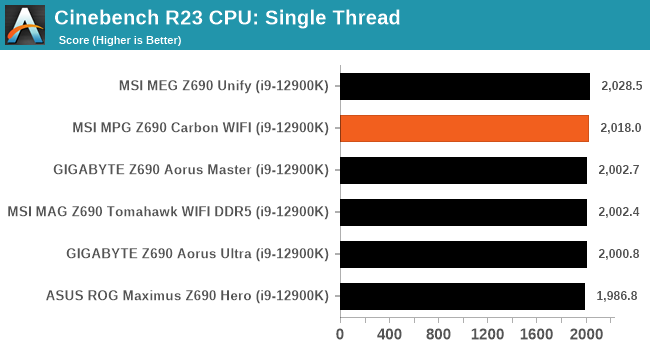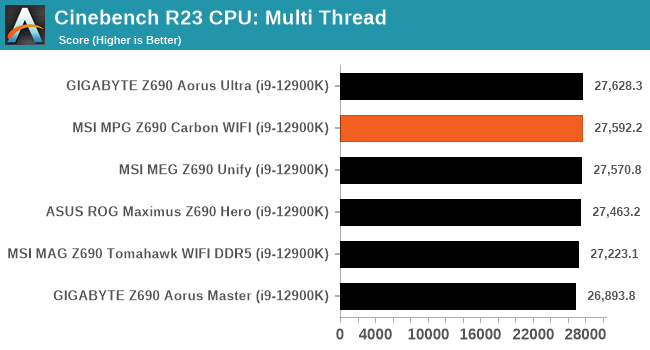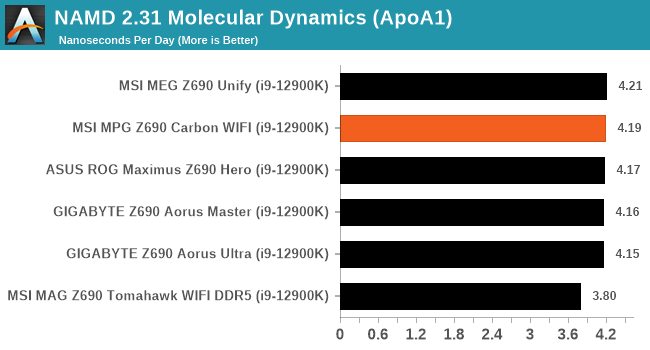The MSI MPG Z690 Carbon WIFI (DDR5) Motherboard Review: A Decent Mid-Ranged Z690
by Gavin Bonshor on September 8, 2022 8:00 AM ESTCPU Performance, Short Form
For our motherboard reviews, we use our short form testing method. These tests usually focus on if a motherboard is using MultiCore Turbo (the feature used to have maximum turbo on at all times, giving a frequency advantage), or if there are slight gains to be had from tweaking the firmware. We put the memory settings at the CPU manufacturers suggested frequency, making it very easy to see which motherboards have MCT enabled by default.
For Z690 we are running using Windows 10 64-bit with the 21H2 update.
Rendering - Blender 2.79b: 3D Creation Suite
A high profile rendering tool, Blender is open-source allowing for massive amounts of configurability, and is used by a number of high-profile animation studios worldwide. The organization recently released a Blender benchmark package, a couple of weeks after we had narrowed our Blender test for our new suite, however their test can take over an hour. For our results, we run one of the sub-tests in that suite through the command line - a standard ‘bmw27’ scene in CPU only mode, and measure the time to complete the render.

Rendering - Crysis CPU Render
One of the most oft used memes in computer gaming is ‘Can It Run Crysis?’. The original 2007 game, built in the Crytek engine by Crytek, was heralded as a computationally complex title for the hardware at the time and several years after, suggesting that a user needed graphics hardware from the future in order to run it. Fast forward over a decade, and the game runs fairly easily on modern GPUs, but we can also apply the same concept to pure CPU rendering – can the CPU render Crysis? Since 64 core processors entered the market, one can dream. We built a benchmark to see whether the hardware can.
For this test, we’re running Crysis’ own GPU benchmark, but in CPU render mode. This is a 2000 frame test, which we run over a series of resolutions from 800x600 up to 1920x1080. For simplicity, we provide the 1080p test here.

Rendering - Cinebench R23: link
Maxon's real-world and cross-platform Cinebench test suite has been a staple in benchmarking and rendering performance for many years. Its latest installment is the R23 version, which is based on its latest 23 code which uses updated compilers. It acts as a real-world system benchmark that incorporates common tasks and rendering workloads as opposed to less diverse benchmarks which only take measurements based on certain CPU functions. Cinebench R23 can also measure both single-threaded and multi-threaded performance.


Synthetic - GeekBench 5: Link
As a common tool for cross-platform testing between mobile, PC, and Mac, GeekBench is an ultimate exercise in synthetic testing across a range of algorithms looking for peak throughput. Tests include encryption, compression, fast Fourier transform, memory operations, n-body physics, matrix operations, histogram manipulation, and HTML parsing.


Compression – WinRAR 5.90: link
Our WinRAR test from 2013 is updated to the latest version of WinRAR at the start of 2014. We compress a set of 2867 files across 320 folders totaling 1.52 GB in size – 95% of these files are small typical website files, and the rest (90% of the size) are small 30-second 720p videos.

3DPMv2.1 – 3D Movement Algorithm Test: link
3DPM is a self-penned benchmark, taking basic 3D movement algorithms used in Brownian Motion simulations and testing them for speed. High floating point performance, MHz, and IPC win in the single thread version, whereas the multithread version has to handle the threads and loves more cores. For a brief explanation of the platform agnostic coding behind this benchmark, see my forum post here.

NAMD 2.13 (ApoA1): Molecular Dynamics
One frequent request over the years has been for some form of molecular dynamics simulation. Molecular dynamics forms the basis of a lot of computational biology and chemistry when modeling specific molecules, enabling researchers to find low energy configurations or potential active binding sites, especially when looking at larger proteins. We’re using the NAMD software here, or Nanoscale Molecular Dynamics, often cited for its parallel efficiency. Unfortunately the version we’re using is limited to 64 threads on Windows, but we can still use it to analyze our processors. We’re simulating the ApoA1 protein for 10 minutes, and reporting back the ‘nanoseconds per day’ that our processor can simulate. Molecular dynamics is so complex that yes, you can spend a day simply calculating a nanosecond of molecular movement.












17 Comments
View All Comments
worldsenvy - Sunday, September 11, 2022 - link
It would be more apt to compare it to if they made the price of eggs $24 for a dozen. 390 for a Mid range board is ridiculous.PeachNCream - Thursday, September 8, 2022 - link
Agreed that PC component prices are utterly absurd at the moment. Some of the cost is tied up in inflation but there is also cost passed onto consumers through the addition of non-functional additions like plastic coverings and lighting. The establishment of various chipset categories (remember when there was basically one chipset to support a CPU generation and it had all the features instead of a set of progressively more stripped down alternatives that now supposedly justify the higher component cost of less feature-limited motherboards?) has done a lot to build a market segment that snags the extra dollars once lost to tinkerers and overclockers that were actually getting extra performance for free instead of pay a price premium for unlocked parts that basically roll the price of overclocking performance gains into said parts.Probably the best thing you can do to shut this sort of garbage from OEMs down is to buy a good enough for work/communication laptop - something lower cost - and either work within its capabilities to play games it can run well. There are lots and lots of games that do not need anything beyond a bottom feeder budget laptop with a garbo iGPU that can keep you amused for the rest of your life. Alternatively, you can always use the cost of a motherboard like this plus a few extra dollars to buy a console. The money you save in additional components can go into the somewhat higher cost of the games on a closed console platform and still buy you a LOT of amusement for the same total price as a desktop gaming PC without any software.
Basically, at this point, gaming PCs are not very cost-effective purchases on just hardware alone. Nevermind the power demands and, if you live in a warm climate, the secondary power costs incurred moving their waste heat out of your home. It's a no-brainer to just change how you entertain yourself a little bit to move the needle to more practical alternatives and you ultimately don't really have to compromise on the end goal of killing time in a fun way either.
meacupla - Thursday, September 8, 2022 - link
List of things making mobos more expensive these days:PCIe 5.0 capable traces
DDR5 capable traces
VRM design that can handle overclocked 12900K
Copper prices have gone up
Supply chain issues
Tariffs
Inflation
That and this mobo is not mid-range. It is high end. It's not a halo product, but it is packed with above average features. IDK why anandtech insists on calling it "mid-ranged", when it's price point is 5th from the top in MSI's intel 12th gen lineup.
MSI Z690 Tomahawk Wifi, and Z690-A Wifi are significantly cheaper.
timecop1818 - Saturday, September 10, 2022 - link
> DDR5 capable tracesThe price difference between PRO-A Z690 and PRO-A Z690 DDR5 is like $15.
meacupla - Thursday, September 8, 2022 - link
Those memory overclock speeds from the corsair kit are abysmal.Is the corsair kit using Micron dies? because I am getting a lot of info that those are trash and can barely hit 5400.
You really need to get your hands on some SK Hynix or Samsung die DDR5, preferably SK Hynix, to see what the mobo is really capable of.
sonny73n - Saturday, September 10, 2022 - link
18 true phase for CPU VRM is way overkilled. Back in Sandy Bridge day, 6-8 true phase considered premium and we could overclock the hell out of the chip. Nowadays processors get heat up too fast, I'd rather leave them on stock clock or underclock in case of GPU.They should instead implement a better audio design with a high end DAC (ESS or AKM comes to mind) and a good headphones amp to drive 600 Ohms headphones.
RestChem - Sunday, September 18, 2022 - link
What kinda baffles me is how quickly all the manufacturers spat out not just a couple but five or more Z690 boards, then for good measure additional some SKUs with tacit DDR5 support (though in all cases I've bothered to check so far the claimed support for dual-rank configs is limited to about five kits total from reference up to 6000) but all their top-end stuff is loused up with WiFi and blinky dragons and various, often questionable airguide/heatsink/EMF-shielding combos as though that's what's going to sell a board to hardcore OCers. Who the hell buys a $500-1000 mobo and connects through WiFi, or would want that on-board? Why not lots of room, great cooling, great unadorned boards and, I don't know, some free GPU braces? How do you sell this thing against the Pro Z690-A at a bit over half the price?